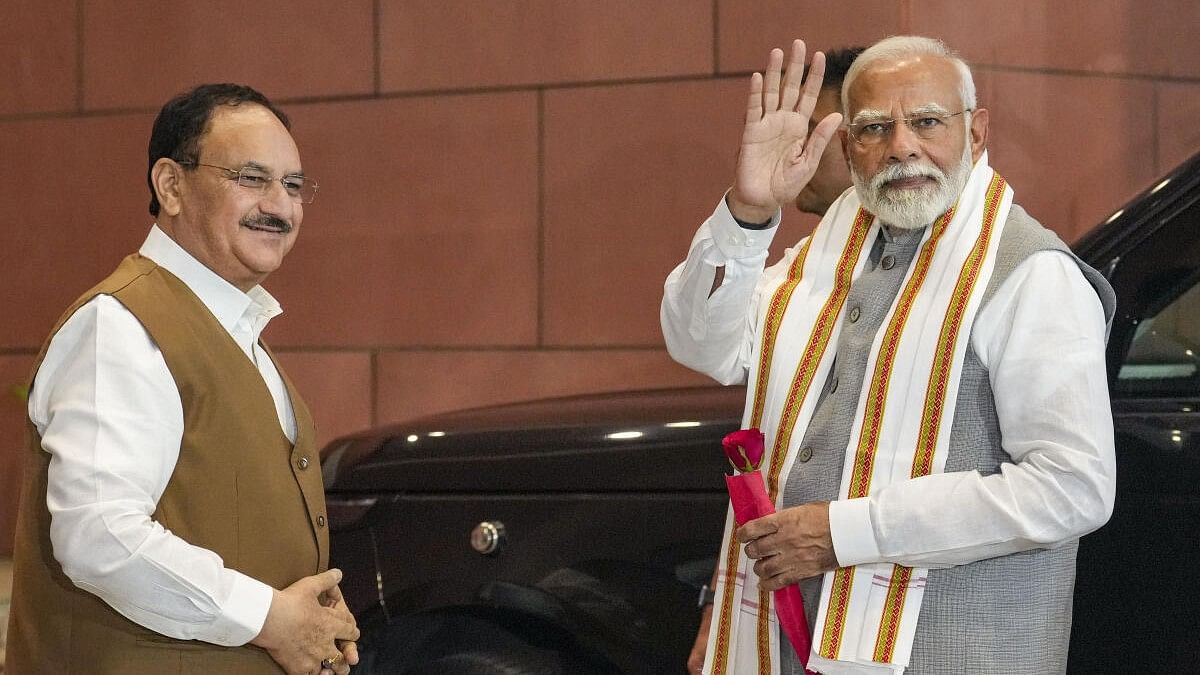
Prime Minister Narendra Modi with Union Health Minister J P Nadda.
Credit: PTI Photo
Recently, the Union government announced that senior citizens aged 70 and above, hailing from families already covered under Ayushman Bharat Pradhan Mantri Jan Arogya Yojana (AB PM-JAY), will be eligible for an additional top-up cover of ₹5 lakh per year. It makes medicare affordable for and specific to the old and infirm.
The logic is the same as the one behind the original scheme — to reduce out-of-pocket expenditure of patients by increasing access to quality and timely healthcare. The scheme separately covers poor families, irrespective of size, per year for secondary and tertiary care hospitalisation.
In its latest avatar, the scheme separately covers those 70 and above, whose medical cover stands separate from the other family members. Otherwise, the scheme is the same for everybody. The new provision creates an opportunity for a critical look at the scheme itself, to understand if it is making the desired difference.
Yes, it is aspirational. Health insurance is no longer a luxury. The amount appears adequate as normally people do not spend ₹5 lakh annually on medical expenses. However, if senior citizens require extended treatment or several persons in a family need treatment in the same year or the condition is something serious, the beneficiaries will find the amount short.
Let’s play devil’s advocate. Many mega-schemes of the government have boomeranged. Due to various reasons, students sold off their free laptops. The poor could not switch to gas-based cooking permanently because they couldn’t afford refills.
Jan Dhan accounts are inoperative or minimally active because of poor savings. The mid-day meal scheme in government schools, especially in the north, suffers from inferior quality and poor monitoring.
What the government must understand is that for these national schemes to become routinised in rural India, they need to be part of a socio-economic reform bundle. You cannot operate laptops without the Internet; that means bringing the waves to the village first before distributing laptops, which means ensuring regular power supply. The linkages are important.
The biggest issue with the scheme is it principally covers inpatient care. Outpatient services are excluded. Ironically, the latter are more frequently needed by the beneficiaries. Notably, inpatient care could be of more help to senior citizens.
The fine print will tell us how frequently the scheme amount will come up for re-appraisal on account of inflation and rising medical costs. As it is, rural and urban, and regional cost variations will decide whether the ₹5-lakh amount is adequate or not.
Even a perfunctory review makes the scheme appear shallow, if you see the big picture. Under-investment in public healthcare is the real culprit, because over 60% of medical expenses for the poor are out-of-pocket expenses. The Ayushman Bharat campaign is yet to fully penetrate rural interiors where primary healthcare is still a mirage.
If doctors are absent and medical infrastructure is poor, access and affordability of health insurance hardly helps. The announcement of the scheme should have been made only after the strengthening of primary and secondary healthcare centres, and district and referral hospitals.
The scheme should specifically allow for covered treatment of diseases peculiar to rural areas such as contagious, infectious, and waterborne diseases, TB, hepatitis, worm infestations, measles, malaria, and respiratory, urinary, and bladder infections.
Or else, there must be schemes which focus on early disease detection or help in prevention thereby reducing the medical burden.
Outpatient doctors’ fees, tests, and treatments must be included in the insurance scheme for the poor. The scheme should allow incentives to those who practice health measures like giving up smoking, consuming alcohol and drugs, among others.
As on date, 17 national and state-level health insurance schemes exist in India. However, there is no convergence, no meeting point between the Centre and the states for a single national scheme.
Worse, some of the exclusionary criteria for the insurance scheme are ridiculous. Those who own refrigerators are excluded. So are those who own a motorbike. Both are not markers of financial security, and such conditions defy logic.
No government can introduce the needed reforms in one go. The first stage can take off by focusing on creating a comprehensive digital system to register the population covered by the scheme linked to diagnosis, diagnostics, treatment, and follow-ups. The second step should be an adequate supply chain of free essential drugs and diagnostics as part of primary healthcare services. This must be followed by ensuring skilled and equipped human resources at the primary health centres. Finally, the government must initiate campaigns to promote awareness about healthy lifestyles and right eating practices among the public, especially beneficiaries of the scheme.
(Venkata Vemuri is a Delhi-based journalist. X: @vvemuri.)
Disclaimer: The views expressed above are the author's own. They do not necessarily reflect the views of DH.